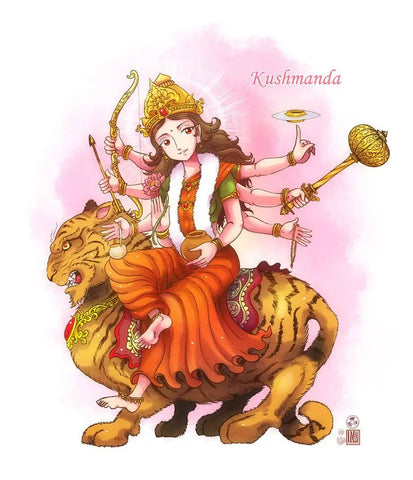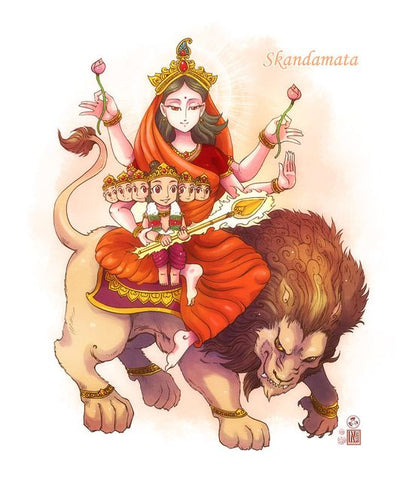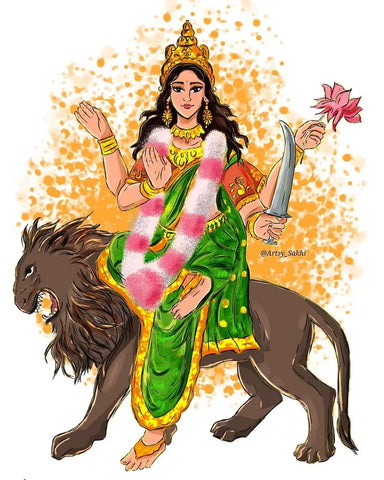Indians wait 356 days for the 9-day celebration of Navratri, a word that we associate with joy, happiness, festival, colours, music, and devotion. Millions of Indians unite in India and around the world to celebrate the nine days-long festival. No matter in which part of the globe you are, a true Indian will experience a change in moods and vibes when Maa Durga arrives. In this blog, we will explore the story of Navratri, its significance in Indian culture, and the lively celebrations of boundless enthusiasm and happiness.
What is the Navratri Festival?
"Navratri" derives from two Sanskrit words: "Nava," meaning nine, and "Ratri," meaning night. In the simplest terms, Navratri translates to nine nights. People in different corners of India celebrate the festival on their own terms. While Navratri is a time to fast for North Indians, it’s a time to savour delectables for East Indians. When Gujrat arranges Garba shows, Kolkata enjoys the beauty of Dhunuchi Naach.
From Indian Sarees to Ethnic kurtis, women dress up in their best attires for the Navratri. Men are not left behind too, because they participate in these 9 days of festivals in their ethnic wear too like Men’s kurtas or Nehru Jackets.
No matter how many festivals Indians enjoy throughout the year, nothing stands a chance in front of Navratri. The festival stands out for its devotion to the divine feminine. It’s a festival that even the world celebrates with immense zeal and fervour. The festival is so firmly rooted in us that Indians, no matter where they are, celebrate with the same joy just like Indians back in their home country.
Story of Navratri
The story of Navratri traces back to an epic battle between good and evil. The indomitable demon Mahishasura wreaked havoc on Trilok - Earth, hell, and heaven. Blessed by Lord Brahma with a boon of immortality, the only condition that can stop him is losing in a battle with a woman. Being overconfident, he became unstoppable.
In response to the cry for help from the gods, the holy trinity – Brahma, Vishnu, and Shiva – pooled their divine energies to create Goddess Durga, a symbol of supreme strength and power. Armed with 10 weapons (Trishul, Sudarshan Chakra, Sword, Vajra, Spear, Snake, Lotus, bow and arrow, mace and conch) and spirits as powerful as a lion, she battled against Mahishasura for 15 days. The demon changed his form several times throughout the fight to confuse and disorient the goddess. But his tricks didn’t work. As soon as he took the form of a buffalo, Maa Durga's trident found its mark, ending his reign of terror.

Image credit:- Unsplash/Sonika Agarwal
Significance of Navratri in Indian Culture
Navratri is not just a time to celebrate Maa Durga’s return to Earth, it’s an emotion that every Indian feels at their core. From strict fasting to Kanya Pooja to dance, galore, and pandal hopping, Indians celebrate these nine nights to their fullest. But behind this celebration remains respect for the divine feminine power and a period of introspection and purification. Each day of Navratri is dedicated to different forms of the divine feminine, known as "shakti."

(image credit:- Prabhat khabar)
The symbolism of Navratri goes beyond all the pomp and celebrations. It's a spiritual journey that signifies the victory of good over evil and the triumph of light over darkness. It's a celebration of connecting with the divine, attaining inner strength, and setting aside the negativity that plagues our lives.
What are the 9 Days of Navratri?
The nine days of Navratri are not just a countdown; each day is significant and each day is dedicated to different forms of goddess Durga.
First Day – Pratipad - A Day for Goddess Shailaputri
On this day, we worship Shailaputri, the daughter of the Himalayas. She symbolizes extraordinary strength.

Image Credit:- Pinterest/Ravi Shankar
Second Day – Dwitiya - Day for Goddess Brachmacharini
It’s the day to worship Devi Brahmacharini, who represents divine consciousness and behaviour.

Image Credit:- Pinterest/Ravi Shankar
Third Day – Tritiya - Day for Goddess Chandraghanta
On this day, Indians worship Chandraghata who consolidates prana (life force energy).

Image Credit:- Pinterest
Fourth Day – Chaturthi - Day for Goddess Kushmanda
It’s time to show our honour to Devi Kushmanda, who showers us with her divine energy.

Image Credit:- Pinterest/Dandavats Dasa Flores
Fifth Day – Panchami - Day for Goddess Skandamata
She is the mother of Lord Kartikeya, Skandamata, who signifies motherly affection and devotees worship her for wisdom, wealth, power, prosperity, and liberation. The Skandamata story is very popular in Indian mythology. When Kartikeya or Skanda slain the demon Tarkasura, mother Parvati became known as Skandamata.

Image Credit:- pinterest/Sharmila Deshpande
Sixth Day – Shashti - Day for Goddess Katyayani
We idolize Devi Katyayani on this day. She annihilated demonic forces to restore balance.

Image Credit:- pinterest/Ravi Shankar
Seventh Day – Saptami - Goddess Kalratri
This is the day to worship Kalaratri, representing the infinite dark energy that houses innumerable universes.

Image Credit:- Pinterest
Eighth Day – Ashtami - Day for Goddess Mahagauri
The day to worship Mahagauri symbolizes beauty, momentum, and freedom in life.

Image Credit:- Pinterest/Sharmila Deshpande
Ninth Day – Navami - Day for Goddess Siddhidatri
A day to celebrate Devi Siddhidatri, who brings perfection to life, making the impossible possible.

Image Credit:- Pinterest
Each day is important to give meaning to the celebration and welcome Maa on Martya or Earth in all her forms.
How is Navratri Celebrated in India?
Unparalleled zeal, scrumptious meals, strictly vegetarian diet or no food at all, dancing, sounds of kasor, ghonta, saankh, Sindoor Khela, dazzling lighting, and new clothes - the Navratri celebrations in India vary across regions but are united by devotion and fervor. The evenings come alive with vibrant dance forms, with Garba and Dandiya.
You Might Like Reading:
6 Must-Have Sarees for Durga Puja
7 Garba Dress Ideas For Navratri 2023
Get Festive-Ready: 9 Banarasi Saree Ideas to Drape in Style
Saree Saga: 6 Handpicked Sarees For The Upcoming Festive Extravaganza
Navratri Captions, Messages, and Quotes in 2023
One of the highlights of Navratri is the tradition of Kanya Puja. On the eighth or ninth day of Navratri, devotees worship young girls who represent one of the many avatars of goddess Durga. Washing the girls’ feet to offer food, Kanjak gifts, and clothing to them, the rituals are one of a kind.
Devotees also come together for prayers, chanting, and meditation. They feel connected with the divine spirit within. The atmosphere is alive with the sounds of devotional music, and the vibrant colours of traditional attire.
Navratri is a celebration that encapsulates the essence of joy, devotion, and spiritual rejuvenation. It's a time when people across India and beyond come together to honor the divine feminine. They reflect on the victory of good over evil and seek inner strength. The nine nights of Navratri represent a profound journey of self-discovery and renewal.
As the vibrant colors, spirited dances, and melodious chants fill the air, Navratri reminds us of the beauty and resilience of the human spirit. It's a festival that embodies enthusiasm, happiness, and a connection with the divine that transcends words. Navratri is not just a festival; it's a celebration of life itself, a reminder that light can dispel darkness.
The festival feels complete when we give our close relatives, family, and friends presents while we also get ready in the best Navratri clothes. It’s a way to spread joy, happiness and good wishes among everyone around us. Take help from iTokri in it. iTokri is an online shop that collects some of the best and not run-of-the-mill Dussera gift. Spread love and joy with iTokri’s Navratri gift collection.
 Verified Purchase
Verified Purchase
























Leave a comment (all fields required)